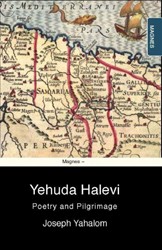Three great achievements make Yehuda Halevi an object of continuing fascination. His poetry’s unmatched mastery of form and language, together with the unexpected range of its moods — amorous, satirical, flattering, and pious — place him at the pinnacle of medieval Jewish literature. His dialogue The Book of the Kuzari is an enduring classic of philosophy. And his abandonment of wealth and privilege in Spain for an unknown end in the Land of Israel represents an almost Zionist impulse to make aliyah.
Hebrew University professor Joseph Yahalom, a scholar of Hebrew poetry, reads Halevi’s life through the poems, supplemented by contemporary correspondence discovered in the Cairo Geniza. Although the book includes a fair amount of technical analysis, and presents many poems in the original Hebrew, Yahalom’s main task is to reconstruct the poet’s life and times based on surviving texts. In topical chapters arranged more or less chronologically, Yahalom situates Halevi in the context of the Muslim-Christian contention over Spain and the Crusader conquest of Jerusalem in 1099. And, like biographers before him, he pieces together the incomplete information that is extant about Yehuda Halevi’s final travels in 1140 as a pilgrim to Jerusalem.Hillel Halkin embarked on a more far-reaching project: an imaginative reconstruction of the poet’s life, with reflections on Halevi’s times and ours. He does not slight the poetry, and takes some pains to explain the forms of a “girdle song” (muwashah) and the differences between secular poems and piyyutim. He also speaks plainly about the content: discussing lines by Shmuel Hanagid he remarks, “The poem throbs with a swaggering and worldly sexuality.” He even makes leaps of insight as he relates poems to Halevi’s life: considering poems about the death of a child, Halkin suggests what this may tell us about Halevi’s own family.
Importantly, Halkin treats the politics and sociology of the time as an integral part of the story, and adds his own observations. He disputes conventional claims about the Golden Age of Spain as a period of tolerance, noting the massacres of Jews in Granada in 1066 and Toledo in 1109. In an unmistakable parallel with our own time Halkin describes the rise of fanatic Almohad Islam in North Africa and its attacks on the moderate Almoravid Muslims who ruled southern Spain.
Joseph Yahalom devotes a short chapter to a consideration of Halevi’s relations with the Karaites, the sect of dissenters from Rabbinic Judaism who follow only the written law of the Torah and not the Talmud. Yahalom finds Halevi sympathetic to the Karaites’ respect for their ancestors and customs but he makes only passing reference to the Kuzari, which began as a critique of Karaism. Halkin’s biography by contrast treats the Kuzari at great length, reviewing the arguments for Judaism to the Khazar king with a commentary sensitive to the dialogue’s drama and interpersonal dynamics.
One of the joys of the Jewish Encounters series, of which Halkin’s book is a part, is the canny pairing of author with subject. Halkin’s early fame came from his Letters to an American Jewish Friend, which made the case for Jews to live in Israel. The epilogue of the Kuzari makes the same point: that talking about the Land of Israel but staying at home is not true to Judaism’s emphasis on taking action. Hillel Halkin, who loves language and Judaism as much as he loves Israel, finds a kindred spirit in Yehuda Halevi. And in Halkin, Halevi finds his ideal biographer.
Book Trailer
Additional books featured in this review
Bob Goldfarb is President Emeritus of Jewish Creativity International.





